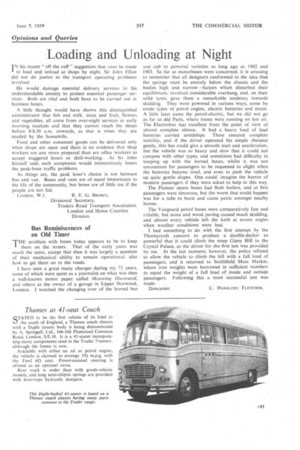Loading and Unloading at Night
Page 85

If you've noticed an error in this article please click here to report it so we can fix it.
IN his recent "off the cuff" suggestion that vans be made I to load and unload at shops by night, Sir John Elliot did not do justice to the transport operating problems involved.
He would damage essential delivery services in his understandable anxiety to protect essential passenger services. Both are vital and both have to be carried out in business hours.
A little thought would have shown this distinguished administrator that fish and milk, meat and fruit, flowers and vegetables, all come from over-night services or early morning markets and that they cannot reach the shops before 8-8.30 a.m. onwards, as that is when they are needed by the housewife.
Food and other consumer goods can be delivered only when shops are open and there is no evidence that shop workers are any more prepared than are office workers to accept staggered hours or shift-working. As Sir John himself said, such acceptance would tremendously lessen the peak-hour traffic problems.
As things are, the peak hour's choice is not between bus and van. Buses and vans are of equal importance to the life of the community, but buses are of little use if the people are not fed.
London, W.I. R. E. G. BROWN, Divisional Secretary,
Traders Road Transport Association, London and Home Counties Division.
Bus Reminiscences of an Old Timer
THE problem with buses today appears to be to keep them on the streets. That of the early years was much the same, except that then it was largely a question of their mechanical ability to remain operational, also how to get them on to the roads.
I have seen a great many changes during my 72 years, some of which were spent as a journalist on what was then a well-known motor paper called Motoring Illustrated, and others as the owner of a garage in Upper Norwood, London. I watched the changing over of the horsed bus and cab to powered varieties as long ago as 1902 and 1903. So far as motorbuses were concerned, it is amusing to remember that all designers conformed to the idea that the springs must be entirely below the chassis and the bodies high and narrow—factors which disturbed their equilibrium, involved considerable overhang, and, on their solid tyres. gave them a remarkable tendency towards skidding. They were powered in various ways, some by crude types of petrol engine, electric batteries and steam. A little later came the petrol-electric, but we did not go as far as did Paris, where trams were running on hot air. The Electrobus was excellent from the point of view of almost complete silence. It had a heavy load of lead batteries carried amidships. These ensured complete stability, and if the driver operated his simple rheostat gently, this bus could give a smooth start and acceleration, but the vehicle was so heavy and slow that it could not compete with other types, and sometimes had difficulty in keeping up with the horsed buses, whilst it was not uncommon for passengers to be requested to alight when the batteries became tired, and even to push the vehicle up quite gentle slopes. One could: imagine the horror of modern passengers if they were asked to help in this way.
The Pioneer steam buses had flash boilers, and at first passengers were timorous, but the worst that could happen was for a tube to burst and cause panic amongst nearby horses.
The Vanguard petrol buses were comparatively fast and reliable, but stone and wood paving caused much skidding, and almost every vehicle left the kerb at severe angles when weather conditions were bad.
I had something to do with the first attempt by the Thornycroft concern to produce a double-decker so powerful that it could climb the steep Gipsy Hill to the Crystal Palace, as the driver for the first test was provided by me. At the last moment, however, the police refused to allow the vehicle to climb the hill with a full load of passengers, and it returned to Smithfield Meat Market, where iron weights were borrowed in sufficient numbers to equal the weight of a full load of inside and outside passengers. Following this a most successful test was made.
Doncaster. C. HAMILTON FLETCHER.




































































































































